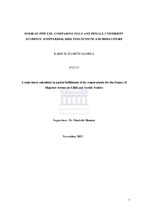| dc.description.abstract | Hookah pipe use is widely viewed as a safe alternative to cigarette smoking rather than a potential health-risk. In fact, for young people hookah pipe use may represent an initial stage of later addiction and the transition to cigarette smoking. Furthermore, studies conducted abroad, suggest that the use of the hookah pipe firstly started as a cultural phenomenon, and secondly, as with cigarette smoking, the hookah pipe has become a social phenomenon. Despite these challenges, studies provide sufficient evidence that hookah pipe use is a potential health risk. The primary aim of the study was to compare male and female university students’ knowledge, risk perceptions and behaviours concerning hookah pipe smoking. A quantitative methodological approach, with a cross-sectional design, was used to conduct the research study. A final self-selected sample of 389 participants voluntarily participated in this study. The final sample included 64% females and 36% males with a mean age of 22.2 years; with the mean age for first-time hookah pipe smoking was 15.7 years. The instrument used was a self-administered questionnaire constructed from The College Health Behavior Survey (2010-2011) which was developed at the University of Missouri-Columbia. Descriptive quantitative results were conducted using Statistical Package for Social Sciences (SPSS version 20) and presented. The results suggest 70% of hookah pipe users daily smoke the hookah pipe with more than 20% smoking on campus. This was similar for males and females. Users perceived the hookah pipe to be less harmful and less addictive than cigarette smoking. Furthermore, smoking the hookah pipe is considered socially acceptable and is also smoked in the family home. Implications for policy are stated. | en_US |

